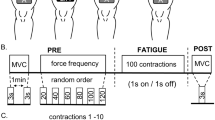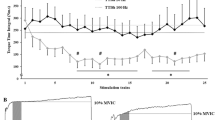Abstract
The aim of the study was to investigate the influence of two different transcutaneous neuromuscular electrical stimulation procedures on evoked muscle torque and local tissue oxygenation. In the first one (MP mode), the cathode was facing the muscle main motor point and stimulus amplitude was set to the level eliciting the maximal myoelectrical activation according to the amplitude of the evoked electromyogram (EMG); in the second one (RC mode), the electrodes were positioned following common reference charts for electrode placement while stimulus amplitude was set according to subject tolerance. Tibialis Anterior (TA) and Vastus Lateralis (VL) muscles of 10 subjects (28.4 ± 8.2 years) were tested in specific dynamometers to measure the evoked isometric torque. The EMG and near-infrared spectroscopy probes were placed on muscle belly to detect the electrical activity and local metabolic modifications of the stimulated muscle, respectively. The stimulation protocol consisted of a gradually increasing frequency ramp from 2 to 50 Hz in 7.5 s. Compared to RC mode, in MP mode the contractile parameters (peak twitch, tetanic torque, area under the torque build-up) and the metabolic solicitation (oxygen consumption and hyperemia due to metabolites accumulation) resulted significantly higher for both TA and VL muscles. MP mode resulted also to be more comfortable for the subjects. Based on the assumption that proper mechanical and metabolic stimuli are necessary to induce muscle strengthening, our results witness the importance of an optimized, i.e., comfortable and effective, stimulation to promote the aforementioned muscle adaptive modifications.



Similar content being viewed by others
References
Atha J (1981) Strengthening muscle. Exerc Sports Sci Rev 9:1–73
Botter A, Oprandi G, Lanfranco F, Allasia S, Maffiuletti NA, Minetto MA (2011) Atlas of the muscle motor points for the lower limb: implications for electrical stimulation procedures and electrode positioning. Eur J Appl Physiol (accepted)
Callaghan MJ, Oldham JA (2004) Electric muscle stimulation of the quadriceps in the treatment of patellofemoral pain. Arch Phys Med Rehabil 85(6):956–962
Celichowski J, Grottel K, Bichler E (1998) The area under the record of contractile tension: estimation of work performed by a contracting motor unit. Acta Neurobiol Exp 58:165–168
Cettolo V, Ferrari M, Biasini V, Quaresima V (2007) Vastus lateralis O2 desaturation in response to fast and short maximal contraction. Med Sci Sports Exerc 39:1949–1959
Chiappa GR, Borghi-Silva A, Ferreira LF, Carrascosa C, Oliveira CC, Maia J, Gimenes AC, Queiroga F Jr, Berton D, Ferreira EM, Nery LE, Neder JA (2008) Kinetics of muscle deoxygenation are accelerated at the onset of heavy-intensity exercise in patients with COPD: relationship to central cardiovascular dynamics. J Appl Physiol 104:1341–1350
Davies CTM, Dooley P, McDonagh MJN, White MI (1985) Adaptation of mechanical properties of muscle to high force training in man. J Physiol 365:277–284
De Haan A, De Jong J, Van Doorn EJ, Huijing AP, Woittiez DR, Westra GH (1986) Muscle economy of isometric contractions as a function of stimulation time and relative muscle length. Pflugers Arch 407:445–450
Delitto A, Robinson AJ (1989) Electrical stimulation of muscle: techniques and applications. In: Snyder-Mackler L, Robinson AJ (eds) Clinical electrophysiology: electrotherapy and electrophysiologic testing. Williams & Wilkins, Baltimore, pp 95–138
Dyke CK, Proctor DN, Dietz NM, Joyner MJ (1995) Role of nitric oxide in exercise hyperaemia during prolonged rhythmic handgripping in humans. J Physiol 488:259–265
Farina D, Blanchietti A, Pozzo M, Merletti R (2004) M-wave properties during progressive motor unit activation by transcutaneous stimulation. J Appl Physiol 97:545–555
Fluck M, Hoppeler H (2003) Molecular basis of skeletal muscle plasticity–from gene to form and function. Rev Physiol Biochem Pharmacol 146:159–216
Hainaut K, Duchateau J (1992) Neuromuscular electrical stimulation and voluntary exercise. Sports Med 14:100–113
Hamaoka T, McCully KK, Quaresima V, Yamamoto K, Chance B (2007) Near-infrared spectroscopy/imaging for monitoring muscle oxygenation and oxidative metabolism in healthy and diseased humans. J Biomed Opt 12(6):62–105
Jensen BR, Jørgensen K, Hargens AR, Nielsen PK, Nicolaisen T (1999) Physiological response to submaximal isometric contractions of the paravertebral muscles. Spine 24(22):2332–2338
Jobsis FF, Duffield JC (1967) Force, shortening and work in muscular contraction: relative contributions to overall energy utilization. Science 156:1388–1392
Knaflitz M, Merletti R, De Luca CJ (1990) Inference of motor unit recruitment order in voluntary and electrically elicited contractions. J Appl Physiol 68:1657–1667
Lai HS, De Domenico G, Stauss G (1988) The effect of different electro-motor stimulation training intensities and strength improvement. Aust J Physiother 34:151–164
Lake DA (1992) Neuromuscular electrical stimulation. An overview and its application in the treatment of sports injuries. Sports Med 13:320–336
Lions GM, Leane GE, Clarke-Moloney M, O’Brien JV, Grace PA (2004) An investigation of the effect of electrode size and electrode location on comfort during stimulation of the gastrocnemius muscle. Med Eng Phys 26:873–878
Lochynski D, Celichowski J, Korman P, Raglewska P (2007) Changes of motor unit contractile output during repeated activity. Acta Neurobiol Exp 67:23–33
MacDougall JD (1992) Hypertrophy or hyperplasia. In: Komi PV (ed) Strength and power in sport. Blackwell Science, Oxford, pp 230–238
Maffiuletti NA (2006) The use of electrostimulation exercise in competitive sport. Int J Sports Physiol Perform 1(4):406–407
Maffiuletti NA (2010) Physiological and methodological considerations for the use of neuromuscular electric stimulation. Eur J Appl Physiol 110:223–234
Merletti R, Knaflitz M, De Luca CJ (1990) Myoelectric manifestations of fatigue in voluntary and electrically elicited contractions. J Appl Physiol 69:1810–1820
Minetto MA, Botter A, Ravenni R, Merletti R, De Grandis D (2008) Reliability of a novel neurostimulation method to study involuntary muscle phenomena. Muscle Nerve 37(1):90–100
Orizio C, Gobbo M, Diemont B (2004) Changes of the force-frequency relationship in human tibialis anterior at fatigue. J Electromyogr Kinesiol 14(5):523–530
Reilly JP (1992) Sensory responses to electrical stimulation. In: Electrical stimulation and electropathology. Cambridge University Press, New York, pp 231–284
Salmons S (1994) Exercise, stimulation and type transformation of skeletal muscle. Int J Sports Med 15(3):136–141
Selkowitz DM (1985) Improvement in isometric strength of the quadriceps femoris muscle after training with electrical stimulation. Phys Ther 65(2):186–196
Smith GV, Alon G, Roys SR, Gullapalli RP (2003) Functional MRI determination of a dose–response relationship to lower extremity neuromuscular electrical stimulation in healthy subjects. Exp Brain Res 150(1):33–39
Snyder-Mackler L, Delitto A, Bailey SL, Stralka SW (1994) Use of electrical stimulation to enhance recovery of quadriceps femoral muscle force production in patients following anterior cruciate ligament reconstruction. Phys Ther 74:901–907
Stevens JE, Mizner RL, Snyder-Mackler L (2004) Neuromuscular electrical stimulation for quadriceps muscle strengthening after bilateral total knee arthroplasty: a case series. J Orthop Sports Phys Ther 34(1):21–29
Stevenson SW, Dudley GA (2001) Dietary creatine supplementation and muscular adaptation to resistive overload. Med Sci Sports Exerc 33:1304–1310
Talbot LA, Gaines JM, Ling SM, Metter EJ (2003) A home-based protocol of electrical muscle stimulation for quadriceps muscle strength in older adults with osteoarthritis of the knee. J Rheumatol 30(7):1571–1578
Watson T (2000) The role of electrotherapy in contemporary physiotherapy practice. Man Ther 5(3):132–141
Author information
Authors and Affiliations
Corresponding author
Additional information
Communicated by R. Bottinelli.
This article is published as part of the Special Issue Cluster on the XVIII Congress of the International Society of Electrophysiology and Kinesiology (ISEK 2010) that took place in Aalborg, Denmark on 16–19 June 2010.
Rights and permissions
About this article
Cite this article
Gobbo, M., Gaffurini, P., Bissolotti, L. et al. Transcutaneous neuromuscular electrical stimulation: influence of electrode positioning and stimulus amplitude settings on muscle response. Eur J Appl Physiol 111, 2451–2459 (2011). https://doi.org/10.1007/s00421-011-2047-4
Received:
Accepted:
Published:
Issue Date:
DOI: https://doi.org/10.1007/s00421-011-2047-4




